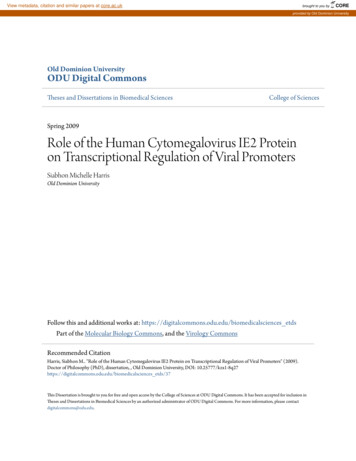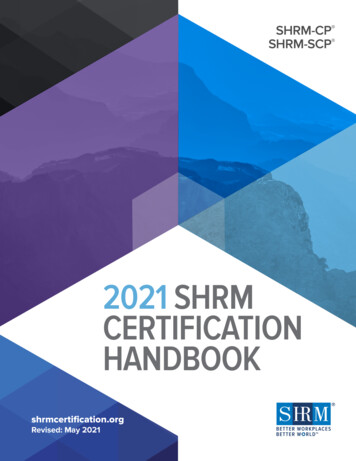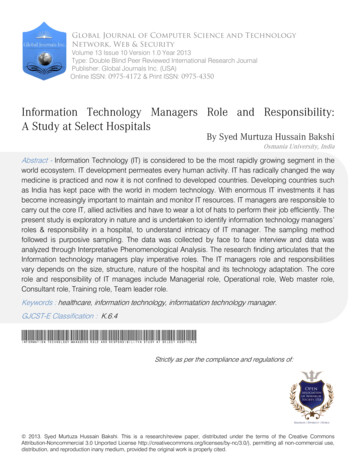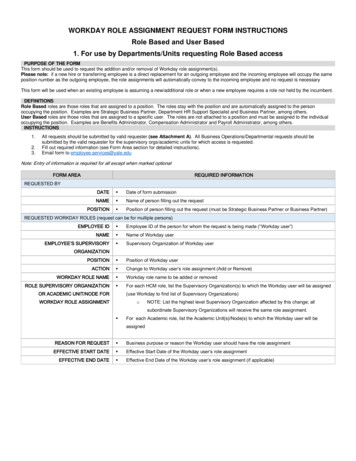
Transcription
View metadata, citation and similar papers at core.ac.ukbrought to you byCOREprovided by Old Dominion UniversityOld Dominion UniversityODU Digital CommonsTheses and Dissertations in Biomedical SciencesCollege of SciencesSpring 2009Role of the Human Cytomegalovirus IE2 Proteinon Transcriptional Regulation of Viral PromotersSiabhon Michelle HarrisOld Dominion UniversityFollow this and additional works at: https://digitalcommons.odu.edu/biomedicalsciences etdsPart of the Molecular Biology Commons, and the Virology CommonsRecommended CitationHarris, Siabhon M. "Role of the Human Cytomegalovirus IE2 Protein on Transcriptional Regulation of Viral Promoters" (2009).Doctor of Philosophy (PhD), dissertation, , Old Dominion University, DOI: iomedicalsciences etds/37This Dissertation is brought to you for free and open access by the College of Sciences at ODU Digital Commons. It has been accepted for inclusion inTheses and Dissertations in Biomedical Sciences by an authorized administrator of ODU Digital Commons. For more information, please contactdigitalcommons@odu.edu.
ROLE OF THE HUMAN CYTOMEGALOVIRUS IE2 PROTEIN ONTRANSCRIPTIONAL REGULATION OF VIRAL PROMOTERSbySiabhon Michelle HarrisB.S. May 2002, North Carolina State UniversityA Dissertation Submitted to the Faculty ofEastern Virginia Medical School andOld Dominion University in Partial Fulfillment of theRequirement for the Degree ofDOCTOR OF PHILOSOPHYBIOMEDICAL SCIENCESEASTERN VIRGINIA MEDICAL SCHOOLOLD DOMINION UNIVERSITYMay 2009Approved by:lie Kerry (Director)Ann Campbell (Member)ichard Drake (Member)Laura Hanson (Member)
ABSTRACTROLE OF THE HUMAN CYTOMEGALOVIRUS IE2 PROTEIN INTRANSCRIPTIONAL REGULATION OF VIRAL PROMOTERSSiabhon Michelle HarrisEastern Virginia Medical School andOld Dominion University, 2009Director: Dr. Julie KerryHuman cytomegalovirus (HCMV) is a ubiquitous pathogen able to cause severemortality and morbidity in immuno-compromised individuals. Successful infection byHCMV is dependent on expression of viral genes essential for replication. Immediateearly (IE) gene products are the first subset of viral genes to be expressed duringinfection and function as key transcriptional regulators.IE2 is one the mostpredominantly expressed IE proteins and is essential for HCMV infection.IE2transactivates several viral promoters, including those of the essential viral DNApolymerase (UL54) and UL112-113 gene regions. IE2 is also able to autoregulate is ownexpression and repress expression of the major IE gene products. This study aims toinvestigate the role of IE2 and cellular proteins in regulation of viral promoters in orderto gain a better understanding of early events required for HCMV replication. Throughthe use of both transient assays and complementing assays in recombinant HCMV clones,we show that single amino acid mutations in the C-terminus of IE2 impair both IE2mediated transactivation of early gene promoters and autorepression of the major IEpromoter.These mutations in IE2 also result in nonviable recombinant viruses,emphasizing the importance of IE2 in HCMV replication.GST pulldown assaysdemonstrate that mutagenesis of Tyrosine 544 in IE2 reduces IE2 interactions with
TATA binding protein (TBP) when compared to the wildtype IE2 protein. Using ChIPassays, we demonstrate that wildtype IE2 is recruited to the UL54 promoter in transientlytransfected cells. However, mutagenesis in the IE2 protein at Proline 535 and Tyrosine544 significantly decrease recruitment of IE2 to the UL54 promoter. Interestingly, thesefunctional defects in mutated IE2 protein had no effect on RNA polymerase IIrecruitment, suggesting that IE2 may function in transcriptional regulation afterformation of the transcriptional pre-initiation complex. In this dissertation, we havefurther characterized regions and functional properties of IE2 essential for UL54activation and HCMV replication.Our studies are significant in understanding theregulation of viral genes essential for replication of HCMV and in the development ofnovel HCMV therapies.
IVThis thesis is dedicated to my husband, Kevin, and our son, Devin.
VACKNOWLEDGMENTSThe present work was conducted at Eastern Virginia Medical School, NorfolkVA, USA and was partially supported by a supplemental doctoral research fellowshipfrom the National Institutes of Health and by Eastern Virginia Medical School.I wish to acknowledge and express my deepest gratitude to everyone who helpedwith the production of this dissertation. I would especially like to thank the following:Kevin Harris, my husband, you were and continue to be my greatest supporter andmost valued shoulder to lean on. Thank you for all your encouragement and patiencethroughout the years. Devin, my son, thank you for being such a great baby, for sleepingthrough the night, and for falling asleep at 7:00 PM to allow your mother could work onher dissertation. I love you both so much.Dr. Julie Kerry, my mentor, I cannot thank you enough for your continuousguidance, support, and encouragement during the time I spent in your lab. Gaurav Basuand Lisa Bolin, thank you both for your friendship, fun times, and never letting me giveup! Dr. Ann Campbell, thank you for your honest advice and refreshing ideas. Dr. LauraHanson, thank you for all your help and thorough explanations. Dr. Richard Drake, thankyou for your continuous support and guidance. The late Dr. Timothy Bos, thank you formaking sure I stayed on my toes and on top of my game. All other graduate students andfriends at EVMS, thank you for making this experience worthwhile.". .and burning with curiosity, she ran across the field after it, and was just in time to seeit pop down a large rabbit-hole under the hedge. In another moment down went Alice,never once considering how in the world she was to get out again."Lewis Carroll, Alice's Adventures in Wonderland
VILIST OF ABBREVIATIONSaaAmino Acid(s)Ala AAlanineATF1Activating transcription factor 1BACBacterial Artificial ChromosomebpBasepairBSABovine serum albuminCRSCis repression sequencecDNAComplementary DNAChIPChromatin ImmunoprecipitationDMEMDulbecco's Modified Eagle MediumDMSODimethylsulfoxideDNADeoxyribonucleic acidDNaseDeoxyribonucleaseDEPCDiethyl pyrocarbonateE. coliEscherichia coliEDTAEthylenediamine-tetraacetic acidgGramgRelative centrifugal forceG6PDGlucose-6-phosphate dehydrogenaseGlu EGlutamic AcidGSTGlutathione S-transferaseHCMVHuman '-2-ethansulphuric acidHHVHuman Herpesvirus
VllhrhourHSVHerpes Simplex VirusIEImmediate earlyIle sidekanKanamycin genekbKilobase(s)kDaKilodaltonLLiterLBLuria croliterminMinuteMIEMajor Immediate EarlymMMillimolarngNanogramntNucleotideODOptical densityPAGEPolyacrylamide gel electrophoresisPBSPhosphate buffered salinePCRPolymerase chain reactionpfuPlaque forming unitsPro PProline
RNaseRibonucleaseRNARibonucleic acidSDSSodium dodecyl sulfateSplSpecificity protein-1TBETris/borate/EDTATBSTris-buffered salineTBS-TTBS with Tween-20TETris-EDTA bufferTEMEDN,N,N',N'-Tetramethylethylendi-amineThr TThreonineTyr YTryrosineULUnique LongUSUnique ShortuvUltraviolet lightVVoltVal eta-D-galactopyranosideZeoZeocin gene
IXTABLE OF CONTENTSPageLIST OF FIGURESxiChapterI. INTRODUCTIONTHE FAMILY HERPESVIRIDAEHUMAN CYTOMEGALOVIRUSHCMV TRANSCRIPTIONAL REGULATIONPROPERTIES OF IE2 PROTEINREGULATION OF THE MIE PROMOTERREGULATION OF THE UL54 PROMOTERSUMMARY1111013181621II. OBJECTIVES OF THIS WORK22III. MUTATIONS IN IE2 DISRUPT TRANSCRIPTIONAL REGULATION OFVIRAL PROMOTERS IN TRANSIENT TRANSFECTIONS.25INTRODUCTION25MATERIALS AND METHODS25RESULTS39DISCUSSION49IV. MUTATIONS IN IE2 INHIBIT REPLICATION AND TRANSCRIPTIONAL REGULATION OF VIRAL PROMOTERS DURING HCMVINFECTIONINTRODUCTIONMATERIALS AND METHODSRESULTSDISCUSSION5353556680V. IE2 RECRUITMENT TO THE UL54 PROMOTER AND INTERACTIONSWITH TBP ARE IMPORTANT FOR UL54 ACTIVATION90INTRODUCTION90MATERIALS AND METHODS91RESULTS98DISCUSSION.:105VI. CONCLUSIONSREFERENCES112115
XVITA132
XILIST OF FIGURESFigurePage1. Schematic diagram of the HCMV virion structure42. Genomic Organization of HCMV63. The HCMV replication cycle74. Assembly of the Basal Transcription Machinery in Eukaryotic Cells115. Genomic Organization of the MIE Gene Region (UL122-123)146. Structure-Function Analysis of the IE2 Protein177. Sequence similarity between CMV species278. Mutations in IE2 inhibit UL54 promoter activity409. Mutations in IE2 inhibit UL112-113 promoter activity4110. Mutations in IE2 relieve alleviate MIE promoter repression4311. Regulation of HCMV promoters by IE2 mutants in absence of other MIE proteins. 4512. Mutations in IE2 increase IE2 mRNA expression in transient assays4713. Mutations in IE2 increase protein expression in transient assays4814. Generation of HCMV Towne BACs which express the IE2 protein mutated at aminoacid 535 or 5446815. Confirmation of Mutant HCMV BACs by PCR and restriction enzyme analysis. 7116. Confirmation of Mutant HCMV BACs by Southern Blot Analysis7217. Growth Curve Kinetics of HCMV WT and WT-Rev virus7418. Replication of HCMV WT and WT-Rev viral DNA in primary fibroblasts7519. gB DNA expression at 1 day post transfection as an indicator of76
xii20. Regulation of the UL54 promoter in BAC transfected cells7921. Regulation of the UL112-113 promoter in BAC transfected cells.8122. Regulation of the MIE promoter in BAC transfected cells8223. Generation of Protein for GST Pulldown Assays10124. Mutation in IE2 Inhibit Interactions with TBP10225. Recruitment of Mutant IE2 Protein to the UL54 promoter10426. Recruitment of RNA Polymerase II to the UL54 promoter in vitro106
1CHAPTER IINTRODUCTIONThe family HerpesviridaeThe Herpesviridae family is generally categorized into three subfamilies:Alphaherpesvirinae, Betaherpesvirinae, and Gammaherpesvirinae. All members of theHerpesviridae family possess the ability to establish persistent and latent infections.Alphaherpesviruses are neurotropic viruses, such as herpes simplex virus (HSV)-l, HSV2, and varicella-zoster virus, which are characterized by a relatively rapid replicationcycle and broad host cell specificity (115). The betaherpesviruses, including humancytomegalovirus (HCMV), human herpesvirus (HHV)-6 and HHV-7, are characterizedby a slow life cycle and species-restricted host range (115).Gammaherpesviruses,including Epstein-Barr virus and Kaposi's sarcoma herpesvirus, are distinguished byslow replication and infection of lymphoid cells (115). Members of the herpesvirusesrepresent an opportunistic group of viruses which are significant human pathogens.Human CytomegalovirusGeneral PropertiesHCMV is the most well characterized member of the Betaherpesvirinaesubfamily. It is distinguishable from other herpesvirus due to its high species-specificityand slow replication period and growth in cultured cells (64). HCMV is a ubiquitous andopportunistic pathogen, easily controlled by a functional immune system in immuno-This dissertation follows the format of Journal of Virology.
2competent individuals. In normal, immuno-competent populations, HCMV infections areusually asymptomatic, although infection may cause a brief mononucleosis-like conditionin some individuals (64). However, in conditions of immune immaturity or suppression,such as neonates, transplant recipients, and AIDS patients, HCMV is a major cause ofdisease and mortality (64). Epithelial cells in the upper alimentary, respiratory andgenito-urinary tracts are thought to be the primary sites of viral replication followingdirect contact (110). After infection, macrophage and endothelial-cell associated virus isimportant in the transmission of virus to other host tissues, such as the heart, lung, liver,and spleen. HCMV can replicate in several cell types including human fibroblasts,epithelial cells, endothelial cells, vascular smooth muscle and macrophages (126).Clinical Significance of HCMVIn the United States, HCMV infection occurs at a rate of 1.6 infections per 100susceptible individuals between 12-49 years of age (25). This rate of infection increasessignificantly in non-Hispanic Black, Mexican American, and low income populations(25).The virus persists throughout an individual's lifetime, and can reactivate inimmunosuppressed periods to cause viral disease. HCMV is transmitted through severalmechanisms: (1) horizontally, through direct contact with bodily fluids such as urine,semen or saliva, (2) vertically, or in utero, from an infected mother to her unborn childand (3) through organ transplants or medical transfusions of blood, platelets, and whiteblood cells (67,104).Infections of most immuno-competent individuals are subclinical and adversesymptoms are limited. However, HCMV infection causes severe disease and mortality in
3individuals with compromised immune systems such as patients with AIDS, patientsbeing treated with chemotherapy and patients undergoing immuno-suppressive therapiesfor tissue and solid organ transplantation (33, 67, 94, 104). Significant clinical symptomsinclude retinitis, gastrointestinal infections, pneumonia and a strong association withorgan rejection (31). Furthermore, HCMV is known to be the major viral cause of birthdefects leading to mental retardation and hearing loss (36, 87, 104). Current treatmentsfor HCMV include ganciclovir and foscarnet, which target the viral DNA polymerase(85). However, since 1991 a number of HCMV strains resistant to ganciclovir andfoscarnet have been isolated from patients and well characterized, demonstratingdiminished efficacy of these treatments (130). Thus, novel therapeutic strategies areneeded to effectively treat HCMV infection.Virion Structure and MorphologyThe virion of HCMV consists of a double stranded, DNA genome (235 kb)contained within an icosahedral capsid, a tegument region surrounding the viral capsid,and a lipid bilayer envelope studded with various virus-encoded glycoproteins (Fig. 1)(94). The capsid is approximately 100-nm in diameter and mature virions range from150 and 200 nm (64). The HCMV capsid is composed of five structural proteins: themajor capsid protein (MCP; pUL86), minor capsid protein (mCP; pUL85), minor capsidbinding protein (mC-BP; pUL46), the smallest capsid protein (SCP; pUL48-49) andportions of the assembly protein (pUL80) (13, 38-40, 51, 123). A tegument or matrixregion, is located between the capsid and the envelope (64). The tegument is composedof approximately 20 proteins with pp65 (ppUL83), pp28 (ppUL83), pp71 (ppUL82) and
4CapsidTegumentGlycoproteinsDNA genomEnvelopeFIG. 1. Schematic diagram of the HCMV virion structure. Mature HCMV virionscontain a large double stranded, DNA genome surrounded by an icosahedral capsid. Theentire virion is surrounded by a lipid bilayer studded with glycoproteins. Between thecapsid and the lipid bilayer is a region called the tegument.
5ppl50 (ppUL32) being the most abundant tegument proteins (6, 118). In addition, amore recent study by Varnum, et al. identified a number of cellular and viral proteinslocated in the HCMV virion through proteomic approaches (141). Approximately 59viral structural proteins and over 70 host cellular proteins, including enzymes andchaperone proteins, have been identified suggesting a possible role of these proteins inthe initiation of viral infection (141).Genome OrganizationThe 235-kb double-stranded, linear DNA genome of HCMV is separated into 2covalently linked segments, referred to as the unique long (UL) and unique short (US)region (Fig. 2) (19). Each segment is flanked by internal (IRL, IRS) and terminal repeat(TRL, TRS) sequences.Gene loci are identified according to their position in thegenome (TRL, UL, IRL, IRS, US, and TRL) (94).Lytic (Productive) Infection.HCMV replicates in a number of susceptible cell types, including epithelial cells,endothelial cells, macrophages, smooth muscle tissues and fibroblasts (Fig. 3) (94). Viralentry involves attachment of virus to the cell surface through glycoprotein gM and gNinteractions with heparin sulphate proteoglycan complexes on the cell surface (94). Theviral glycoprotein, gB, has also been found to interact with the epithelial growth factorreceptor (EGFR) to initiate viral entry (145). However, several EGFR-negative cell linesare permissive to HCMV infection, suggesting other receptors are involved ttachmentofthe
6Kilobasepairs (kbp)01530456075901051IIIIIIIULTRL120 135I150165180 195I210l225235l FHIRL IRSTRSFIG. 2. Genomic Organization of HCMV. The HCMV genome contains two uniquesegments, unique long and unique short (solid lines), flanked by inverted repeatsequences (open rectangles). Gene loci are named according to their position along thegenome.
71 Viral Attachment2 Viral Fusion/Entry3 Transit to the Nucleus4 Circularization of Viral DNA5 Viral Gene ExpressionCapsid Assembly7 Exiting8 Capsid Maturation9 Budding of Capsid fromGolgi10 Virus BuddingFIG. 3. The HCMV replication cycle. Please refer to text for additional information onHCMV replication.
8viral particle to the cell surface, fusion occurs between the cell membrane and the viralenvelope. The gH/gL/gO heterotrimeric complex is required for membrane fusion (49).The virus particle is then released into the cytoplasm and within minutes, transits to thenucleus. Transport through the nuclear pore allows the viral DNA to be deposited intothe nucleus and to be transcribed into mRNA by the cellular DNA dependent RNApolymerase II (31).A number of cellular signaling pathways are activated by binding and/or fusion ofthe HCMV virion to the cell membranes (32). Several pathways thought to be importantfor successful virus replication and immune evasion are activated, including modulationof calcium levels, activation of phospholipases C and A2, and release of arachidonic acidand subsequent metabolites (32). Activation of these pathways occur in the absence ofviral expression, as demonstrated through the use of UV-inactivated virus, suggestingthese actions are triggered by structural proteins involved in viral attachment and/orpenetration. Viral attachment also triggers activation of cellular factors such as SP1,myc, c-fos/c-jun,NF-KB,ERK1/2, p38, and phosphatidylinositol 3-kinase (PI3-kinase)which are thought to prepare the cell for virus infection (8, 10, 56, 66, 157). In addition,prior to de novo protein synthesis, attachment and penetration of HCMV is able to triggerimmediate effects on the host cell through the actions of tegument proteins andglycoproteins (33). Specifically, pp71, a tegument protein, has been shown to enhanceactivation of cellular promoters containing CREB/ATF and AP-1 regulatory elements(75).Similar to other herpesvirus, the expression of HCMV genes are temporallyregulated within the nucleus of the host cell in the following order: immediate early (IE),
9early and late gene expression (64). The first subset of viral genes to be expressed are theIE gene products (64). The major IE (MIE) proteins, including IE1 and IE2, are the mostabundantly expressed proteins during the IE phase (16, 94). Unlike early and late genes,IE genes do not require de novo cellular or viral protein synthesis, as determined bycyclohexamide treatment, and can be expressed within several hours following infection(64). As mentioned previously, IE promoters are primarily dependent on cellular proteinsalready present in the cell for activation (32).A large majority of IE proteins facilitate the activation of HCMV early genes(104, 148). Early genes are typically involved in the replication of the viral genome andmay code for structural proteins (94).Examples of early viral genes required forreplication include the UL54 gene, which encodes the virus DNA polymerase, andUL112-113 gene products, which encode a number of phosphoproteins required forreplication (94).Late gene products are produced after initiation of DNA replication and encodeproteins primarily involved in virion assembly, maturation, and spread (94). In additionto early gene activation, several of the IE proteins are involved in activation of late genes.For example, IE2 regulates expression of pp28, a tegument protein (60).HCMV DNA replication begins approximately 24 hours post-infection (hpi) andpeaks at 48-72 hours in human fibroblasts (88). Viral DNA replication occurs through arolling circle mechanism resulting in concatemeric molecules (88). DNA is then cleavedand packaged into capsids as linear, double stranded DNA (88). After packaging, currentresearch suggests that HCMV intranuclear capsids bud through the nuclear membrane,losing their primary envelope, and acquire a final envelope and tegument in cytoplasmic
10compartments (93). Following tegumentation, the viral particle undergoes a secondenvelopment in the trans-golgi. assembly compartment where it will obtain additionalviral glycoproteins (13, 93). Finally, HCMV particles are released from the cell and enterinto the intercellular space in order to infect nearby cells (93).HCMV Transcriptional RegulationTranscriptional regulation of cellular and viral genes is a highly controlled andregulated process (Fig. 4).During virus infection, HCMV "hijacks" the cellulartranscription machinery to enable transcription of viral genes (32). Transcription ofcellular genes involves the assembly of a transcription pre-initiation complex at thetranscription start site ( 1) of the designated promoter (15). The TATA box, located atposition -25 to -30, is recognized by the TATA-binding protein (TBP), a component ofthe TFIID complex. The TFIID complex consists of TBP and TBP-associated factors(TAFs). TFIIA and TFIIB are then recruited to the pre-initiation complex to assist inTFIID binding. Next, TFIIF and RNA polymerase II bind to the pre-initiation complex.TFIIE and TFIIH are recruited to allow transcriptional initiation and RNA polymerase IIphosphorylation (15).General transcription factors, such as SP1, CREB, and/or API aid in recruitmentof the TBP and RNA polymerase II protein complex to the promoter (47, 73).Transcription factors also facilitate recruitment of two types of enzymes, ATP-dependentchromatin remodeling enzymes and histone-modifying enzymes which function tocontrol accessibility of the transcriptional machinery to the promoter (96, 139, 140).
11FIG. 4. Assembly of the Basal Transcription Machinery in Eukaryotic Cells. Initiationof transcription in eukaryotic cells involves a complex interplay of cellular factorsrecruited to individual promoters. Please refer to the text for additional information ontranscriptional initiation.
12ATP-dependent chromatin remodelers, such as SWI/SNF and Gcn5, disrupt histone-DNAcontacts of the nucleosome (96, 139, 140). Histone modifying enzymes, such as P/CAFor p300/CBP, posttranscriptionally modify the N- and C-terminal tails of histone proteinsfor transcriptional regulation (7, 96, 139, 140).Most regulatory proteins involved in eukaryotic gene transcription are termedactivator or repressor proteins and possess a modular structure comprised of distinctfunctional domains including, but not limited to, a DNA binding and a transcriptionalregulatory domain (11, 34). The DNA binding domain is usually specific for individualpromoter sequences (34). The transcriptional regulatory domain facilitates transcriptionalactivation or repression through properties such as recruitment of co-regulators orinteractions with basal transcription machinery (23, 24, 34).Coactivators are proteins that do not bind directly to DNA, but function intranscriptional activation of RNA polymerase II promoters. Coactivators can regulatetranscription by one or more of the following mechanisms (1) serving as a scaffoldingfactor at the promoter between transcription factors and members of the basaltranscription machinery, (2) interacting with the basal transcription machinery, and/or (3)recruiting or functioning as histone modifiers (42, 55, 95, 100, 101, 150).HCMV infection leads to an increase in the RNA and DNA synthesis within aninfected cell, including an increase in expression of cellular transcription factors (32,129). The IE2 protein is then able to interact with several cellular proteins involved intranscriptional regulation. IE2 has been shown to interact with members of the basaltranscription machinery, including TBP, TFIID, and TBP-associated factors (TAFs) (43,44, 57, 58). IE2 also interacts with a number of cellular transcription factors such as SP1,
13API, and CREB (68, 119, 120, 146). In addition, IE2 has been found to interact withchromatin remodeling proteins such as P/CAF, p300/CBP, and HDAC3 (14, 98). Basedon these properties of transcriptional regulation, IE2 appears to function as a coactivatorto stimulate activation of several viral promoters. In this dissertation, we will furtherinvestigate the functions of IE2 at viral promoters and identify properties involved inregulation of transcription.Properties of the IE2 ProteinIE2 Gene ExpressionThe majority of IE transcription occurs from the UL122/123 gene region, termedthe major IE gene region (Fig. 5) (19). The major IE gene region encodes several splicevariants during virus infection (135, 136, 138). The IE1 72 kDa and IE2 86 kDa proteinsare the most abundantly expressed gene products from this locus and play a significantrole in transcriptional regulation of viral genes (16, 94). These gene products share 85amino acids in the N-terminus (135, 136, 138). In addition, the MIE promoter drivesexpression of a number of minor transcripts with sequences overlapping IE1 and IE2which are currently not well-characterized (54, 63, 111, 125, 133). Regulation of theMIE promoter is controlled by both cellular and viral factors, as described later in thisdissertation.Regulation of Viral Gene TranscriptionIE2 is a potent transactivator of viral and cellular genes and is essential for viralreplication (45, 74, 86,107,109,134). This protein activates a number of HCMV early
14AATAAAh—IAATAAAEKdiis'i4»4AATAAAIAATAAAAUG 4 . MIEpremoteri-iHi-iiAUG 4 .6x01,4H i H g H f r E1AUG . 4 .ExonsT11H1H3-,E2FIG. 5. Genomic Organization of the MIE Gene Region (UL122-123). The major IEgene region (UL122-123) is the most extensively transcribed region during the immediateearly phase of viral gene expression. The major IE promoter encodes a number of splicevariants (not all variants are shown). The IE1 and IE2 gene products are the mostpredominant UL 122-123 gene products expressed. Figure adapted from (79).
15promoters that are required for viral replication, including the UL112/113 (encoding fourphosphoproteins required for replication) and UL54 (encoding the viral DNApolymerase) gene promoters. IE2 also activates a variety of heterologous cellular andviral promoters, regulating expression of the cyclin E, c-fos, hsp70 genes and the humanimmunodeficiency type I (HIV-1) long terminal repeat (28, 94, 120, 121, 128, 132, 156).Regulation of viral and cellular genes is thought to be mediated by direct bindingof IE2 to DNA and/or protein interactions with cellular and viral transcription factors (33,128).Activation of TATA-containing promoters, such as the c-fos and HIV LTRpromoter, is thought to be mediated by IE2 interactions with members of the basaltranscription machinery, TFIIB and TBP (43, 44, 57, 58). IE2 is also able to interact withcellular transcription factors to regulate viral gene transactivation, including SP1, CREB,API (68, 119, 120, 146). In addition, IE2 has been found to interact with histonemodifiers such as P/CAF and HDAC3, suggesting IE2 is involved in chromatinmodification to facilitate transcriptional activation (15, 95, 155). IE2 can also regulateearly gene transcription by direct binding to DNA (2, 18, 48, 121, 122). For example,expression of UL112-113 gene products is regulated by an ATF/CREB binding site and anonessential IE2 binding site, identified by deletion mutagenesis and gel mobility shiftanalysis (120, 121). Deletion of this IE2 binding site in UL112-113 within a HCMVrecombinant virus causes a reduction of IE2-mediated transactivation of this promoterduring infection (114).
16Structure-Function AnalysisAs a result of the essential role of IE2 in viral replication, numerous studies havebeen performed to identify functional domains of the IE2 protein and assess thebiological significance of these regions (Fig. 6). Two distinct regions of the N- and Cterminus of IE2 are involved in transactivation of early genes (amino acids 1-98 and 195570) (46, 84, 108, 122, 127, 134, 154). In addition to a transactivation function, the Cterminus of IE2 also plays a role in autoregulation (20, 48, 69, 74, 83, 107) and bindingto cellular transcription factors and members of the basal transcription machinery (17, 22,58, 127). Due to this large overlap of function domains, it is difficult to determinespecific regions of IE2 important for a single function.Mutational analyses of IE2performed by Asmar, et al. identified a region in IE2 between amino acids 450 and 544that plays a major role in IE2 transcriptional regulatory properties during transienttransfections, referred to as the "core" region (3). Mutations in the core region oftransfected fibroblasts disrupted DNA binding of IE2 to the MIE promoter,autoregulation of the MIE promoter and transactivation of UL112-113 promoter (3).Research in our laboratory has shown that insertion of 4 amino acids at amino acid 349 or540 result in a 6-fold or greater decrease in activation of the UL54 promoter in transienttransfections (134).These insertions also resulted in a 10-fold increase of MIEPactivation (134). Based on these results, it has been suggested that the IE2 regionsinvolved in transcriptional activati
20. Regulation of the UL54 promoter in BAC transfected cells 79 21. Regulation of the UL112-113 promoter in BAC transfected cells. 81 22. Regulation of the MIE promoter in BAC transfected cells 82 23. Generation of Protein for GST Pulldown Assays 101 24. Mutation in IE2 Inhibit Interactions with TBP 102 25. Recruitment of Mutant IE2 Protein to .










